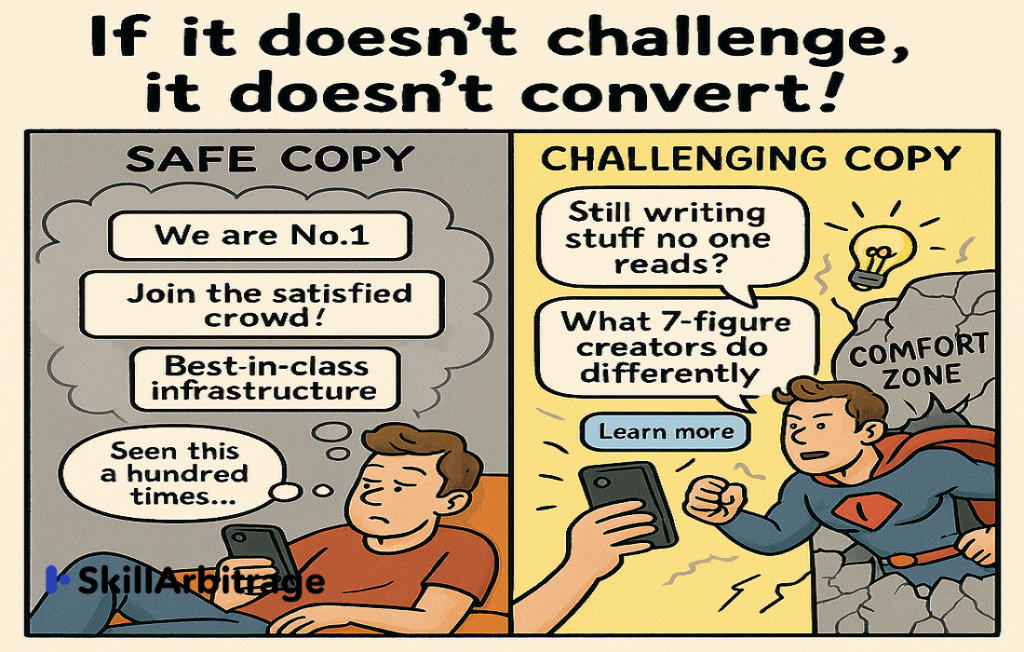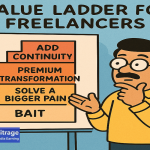This article will show you how to integrate challenges in copy to make them more powerful. It would be a useful resource for content writers, marketers, startup founders and small business owners who want to make their messages create unique impressions.
Table of Contents
Introduction
Most Indian consumers remember the Surf Excel ad with its powerful slogan “Daag Acche Hain” (Stains are Good).
With this campaign, the popular detergent brand, Surf Excel, challenged the premise that dirt and stains as something bad that needs to be hidden or obliterated, the very premise that other brands followed to market their products.
This standout campaign said “Stains are good” instead, and showed several scenarios like a little brother helping his sister or children playing outside, to establish that stains were, in fact, a part of life.
The ad went on to grab a massive number of eyeballs and the campaign went down in advertising history.
What was the thing that worked in its favor?
Was it particularly clever? Did it have a lot of puns or huge celebrity star power?
- No, no, and no!
What worked was the act of challenging an established norm, which no one had dared challenge before.
Let me ask you now, before you came to read this blog, how much content did you have to swim through?
Count all: the articles, the news, the ads…if you have not come to read this blog directly after waking up, there are chances that you came across quite a few.
Now tell me, how many do you remember? I am guessing, not many,
In a digital world, the audience is drowning in information and clever copies, yet most of them don’t remember a single one at the end of the day.
Generally, a copy doesn’t fail to convert because it’s wrong. Often it sinks because it’s simply forgettable.
Countless content writers have encountered the same dilemma.
Deadline vs. standout copy!
Typically, there is the ever-pressing deadline, the slowly rising wave of panic, and an innate desire to make the copy stand out.
Most of us have been at that sad chair, handing out a piece of bland writing, hoping against hope that it would work, but knowing that the chances were slim.
Yet there is a quick hack to make any copy work.
Take the Surf Excel route – position it as a challenge.
Challenges are uncomfortable, they dare you to think. That little sting of discomfort? That’s the beginning of persuasion.
When your words don’t challenge the reader, don’t poke, provoke, or press, they fade into the background noise. And if your copy doesn’t challenge, it doesn’t convert. Period.
Let’s explore why challenging your reader isn’t just a clever trick—it’s a conversion-driving, brand-defining necessity.
Why safe copy doesn’t sell
Safe copy mostly comes easy and feels good to write. It’s polite, correct, effortless.
But easy copy rarely grabs attention—or wallets.
According to a recent study, the average human attention span has dropped to just above 8 seconds, which is slightly less than the average attention span of a goldfish, at 9 seconds.
Combine that with the fact that people are exposed to around 6,000–10,000 ads per day, and the problem becomes clear: if you’re not disrupting autopilot mode, you’re invisible.
Safe copy sounds like:
- “We are No.1”
- “Our state-of-the-art infrastructure…”
- “Join the crowd of people who benefitted!”
How often have you encountered these phrases in ads, landing pages, and emails? And how many of them inspired you to take action?
None, right?
Because that’s corporate wallpaper. No tension, no curiosity, no conversion.
But when you read something like: “Still writing stuff that will fade into oblivion?”—you pause. You feel seen. Maybe a little exposed. That’s the start of a challenge—and the start of copy that sells.
What is “challenge” in copy?
Challenging copy doesn’t insult your reader. It confronts their assumptions, beliefs, or comfort zones. It shows them a mirror that makes them feel uncomfortable.
Think of it like a coach pushing an athlete to perform better. “You think that’s good?/ Are you happy?/ Is that all you have got?”
That’s exactly what challenging copy does. It nudges and pushes.
The challenges can be of various kinds.
Look at these examples:
- Belief challenge: “SEO is dead. Here’s what smart content writers do now.”
- Status challenge: “Freelancers who don’t charge in USD are leaving money on the table.”
- Skill challenge: “If you can’t explain your offer in 10 words, you don’t know it.”
These lines don’t just inform. They demand reflection. They create tension—a critical ingredient in persuasion.
As copywriter Joanna Wiebe, puts it, “Copywriting isn’t about being nice. It’s about moving people to act.”
Remember, that not all challenges convert. It is a fine balance.
Make it too hard and the audience will lose interest, make it too easy and they will forget.
So we have to find the right kind of challenge.
Types of challenges that convert
Here are some of the most popular challenge-based messages popular in specific industries.
Now that I have explained this, you might spot many challenge-driven messages around you.
The good news?
It is not a trend. People respond to challenges because it’s hard-wired in their brains.
The psychology behind challenging copy
Why does the challenge work? Why do we feel compelled to take action when challenged?
Because human beings hate comfort zones. Let that sink in.
Three silent psychological factors come into play when a potential target comes across a copy that challenges their value systems, comfort zones, and self-imposed boundaries.
1: Cognitive dissonance
When readers are presented with a conflict between their beliefs and a bold new idea, they feel internal tension. To reduce that tension, they either dismiss the message—or explore it.
Copy that says, “Your business isn’t growing because you’re avoiding hard decisions,” doesn’t play blame games.
It creates relatability and a tension the reader wants to resolve.
2: Pattern interrupt
When someone is scrolling through his or her phone, 9 out of 10 times its just out of habit, they are aimless and probably bored.
Challenging lines jolt the brain out of passive scrolling. This is known as a pattern interrupt, a marketing technique proven to increase engagement.
3. The Zeigarnik effect
This principle says we remember incomplete tasks or unresolved ideas better. When a line challenges us without resolving it immediately, it is stuck in our mind, like a familiar tune we can’t remember the words to.
That’s why hooks like “Most ads fail. Here’s why.” make us click.
But there is a difference between sparring and a knockout punch. Many marketers go above board and repel the same consumer they were trying to attract, ironically.
But done correctly conversion rates can touch the sky. Take a look at this snapshot of everything we have been discussing till now, plus some mindblowing conversion statistics.
What should you do to ensure that your challenges resonate without losing the consumer?
One-word answer – empathy.
How to challenge without alienating
There’s a fine line between being compelling and being crass. A challenge that feels like a personal attack will push readers away, while one that’s too soft won’t spark action.
The key is empathy—making readers feel seen, understood, and inspired to act. Here are tricks and a step-by-step approach to ensure your challenges resonate and do not repel.
Tricks for empathetic challenges
Challenge ideas, not people
Avoid blame in messaging, they make the brand look like a sneering school bully.
For example, “You’re lazy” is in bad taste. “Most people struggle to stay focused. You’re not alone—here’s the way out.” is helpful and responsible.
One of the most effective ways of injecting challenge in copy without offending the reader was the “Gap Revelation” technique.
This shows the distance between where the reader is and where they could be. Instead of finger-pointing, this technique offers a window into what they’re missing out on. This triggers curiosity, not defensiveness.
Example:
- Harsh: “You’re doing content marketing wrong.”
- Constructive: “What 7-figure creators do differently in content marketing (that you can start today).”
This empathetic nudging acknowledges a common struggle, while offering hope, keeping the reader engaged.
Create discomfort, then offer a resolution
Effective challenging copy raises a problem and provides a path forward in the same piece of content. For instance: “If your portfolio hasn’t gotten you a gig in 90 days, it’s not your portfolio—it’s your pitch.”
Follow it with: “Here’s how to fix it.” Failure to provide a solution leaves readers frustrated, and they may not associate you with the answer they seek.
Use stories or proof
Challenging copy builds tension, solutions resolve it, and proof seals the deal. Share relatable anecdotes or data to back your challenge. For example: “I wasted 3 months writing blogs no one read—until I stopped writing what I thought people wanted.” This story empathizes with the reader’s struggle and proves your solution works.
Flip it on its head
Want to rewrite a generic piece of copy as a challenging one? Use the Flip Framework.
For this, there are some easy steps to follow. They include 1) spotting the comfort zone in the copy, 2) flipping it by confronting an avoided truth 3) adding a contrasting sequence.
Example:
Bland: “5 easy ways to write better Instagram captions.”
Challenging: “Still writing captions that get scrolled past? Try these 5 hacks before the algorithm buries you.”
The magic of crafting challenging copy unfolds in five easy steps. Follow these to arrive at an effective copy that challenges without creating animosity.
Step-by-step guide to crafting empathetic challenges
Instant noodles, a staple in Indian households, are a simple food loaded with resonance. From school tiffins to barely awake meals, at the end of another hectic day, instant noodles have been a fond part of Indian kitchens for decades.
Let’s take this humble product and craft copy powered by challenges, around it.
Identify the reader’s pain point
Start by pinpointing the specific frustration, fear, or goal your audience faces. Ask: What’s guilting them on sleepless nights? For instant noodles, the pain point might be the guilt of choosing convenience over health or the monotony of repetitive meals.
Example: So, a hook like “Tired of feeling guilty about quick meals that lack nutrition?” targets the health-conscious parent or students effectively.
Frame the challenge as a question or observation
Use questions or neutral observations to spark reflection rather than blame. When you are asking the reader, “Too lazy to cook again?” you are showing judgment. Questions like “Still settling for bland, unhealthy noodles?” or observations like “Most people think instant noodles can’t be exciting” invite curiosity without attacking the reader’s choices.
Example: “Most families rely on instant noodles for speed. But are you missing flavor and nutrition?” This observation challenges without accusing.
Acknowledge shared struggles
Show empathy by validating the reader’s experience or the difficulty of change. Phrases like “It’s tough to…” or “We’ve all been there…” build a bridge between you and the reader. This makes your challenge feel like a coach’s nudge rather than a critic’s jab.
Example: “We all know it’s hard to find time for healthy meals when life’s so busy. But is ‘quick’ costing you variety?”
This acknowledges the time crunch before pushing.
Offer a clear, achievable solution
After creating tension, provide a specific, actionable way to resolve it. The solution should feel easy and tied to your product.
Example: “Want tastier, healthier noodles? Try our new protein-packed masala flavor in just 3 minutes.”
This feels highly doable and highlights the product’s value.
Back it up with proof or a story
Reinforce your challenge and solution with evidence—data, testimonials, or a personal anecdote. This builds credibility and shows the challenge is surmountable. The proof makes the reader believe change is possible and compels him to take action.
Example: “90% of our customers say our nutrient-rich noodles transformed their quick meals. Ready to taste the difference?” This stat proves the solution works. If you do not have the stats, use a personal anecdote, “I was tired of the same bland bowl of noodles every night, but a treat was just around the corner.”
What’s the surefire way to know if your copy is “challenging enough” to convert?
Ask yourself: “Does this copy risk making the reader uncomfortable — but in a productive, empowering way?” If it feels too safe or agreeable, it’s probably not triggering the urgency required for conversion.
Try the fridge-magnet test: if your line could sit comfortably on a mug or motivational poster, it’s not challenging enough. Reframe with tension.
Like this:
- Safe: “Our noodles are the best”
- Challenging: “Still settling for bland noodles that taste like cardboard strips?
Challenge is the new CTA
The best copy doesn’t just make a point. It makes a demand.
It says: Are you ready to grow? Ready to let go? Ready to become who you say you are?
Here I have told you how to harness the tremendous power of an empathetic challenge, why it works, how much it converts, and how to do it.
The challenge is not arrogance. It’s respect. It tells the reader, “I believe you’re capable of better.”
And if you’re a content writer, here’s your challenge: Don’t just describe features. Don’t just add adjectives. Dare your reader to act and make that purchase.
Remember anything is better than writing something that sinks into oblivion without a fight.
Because what doesn’t fight back is not remembered.
Because what doesn’t challenge, doesn’t convert.
FAQs
Q1. How do you balance being provocative without being polarizing or offensive?
A: The goal is not to attack the audience — it’s to hold up a mirror. Avoid personal jabs or moral judgments. Challenge their assumptions, habits, or industry norms, not their identity. Focus on unlocking their potential or calling out missed opportunities.
Q2. Can challenging copy work for nurturing and retention stages, not just awareness?
A: Absolutely. In the nurture or retention phase, challenge becomes even more nuanced. Instead of “Why haven’t you started?” it shifts to “Why haven’t you gone further?” Challenge your existing users to evolve, upgrade, or deepen their commitment. Example: “You’ve come this far — why stop before the breakthrough?”
Q3. What are some psychological triggers that make challenge-based copy so effective?
A: The strongest triggers are cognitive dissonance, status anxiety, and loss aversion. When you challenge someone’s belief, identity, or comfort zone (gently but directly), it creates tension — and humans are wired to resolve tension. Good copy opens a gap; great copy dares the reader to close it.
Q4. Is there a risk of challenge fatigue? Can it stop working if overused?
A: Yes. If everything is framed as a challenge, it can become white noise or even anxiety-inducing. Think of challenge as a sharp note in a melody, not the entire song. Use it selectively — especially in CTAs, hero copy, or social hooks — to reignite urgency. The rest of your messaging should offer clarity, value, and support.
Q5. How can AI tools help you craft high-converting, challenge-driven copy?
A: AI tools like ChatGPT, Jasper, and Copy.ai can quickly generate base drafts — but to add challenge, prompt them smartly. Example: “Rewrite this copy to challenge complacent behavior among [audience] without sounding accusatory.” Then tweak for tone. You can also feed in customer objections and ask the AI to frame them as provocations.
Q6. How can a challenge-based copy be A/B tested effectively?
A: Test subtle versus bold provocations. For example, one version might ask “Ready to level up?” while another pushes harder: “Still waiting for permission to win?” Monitor not just clicks, but scroll depth, time on the page, and bounce rates — challenge might spike attention but requires clarity to retain interest.
Q7. What’s the future of challenge-based copy in the AI era?
A: As AI floods the internet with agreeable, generic content, challenge will become a major differentiator. Brands and creators that dare to challenge assumptions, behavior, or mediocrity will cut through the sameness. The edge lies in tone calibration: human editors who know how to blend empathy with provocation will lead the next wave of high-conversion copy.







 Allow notifications
Allow notifications
